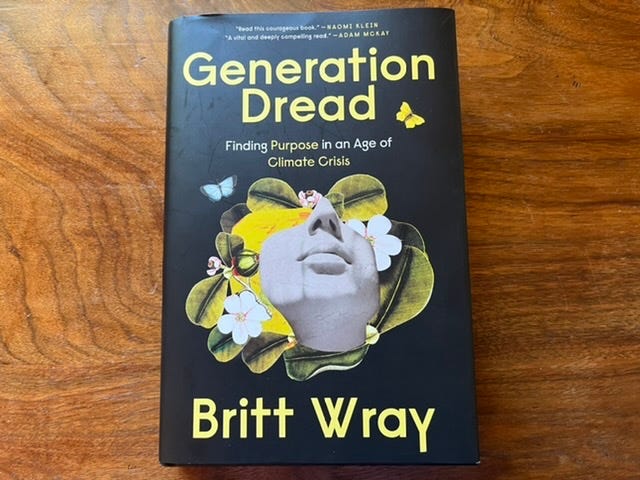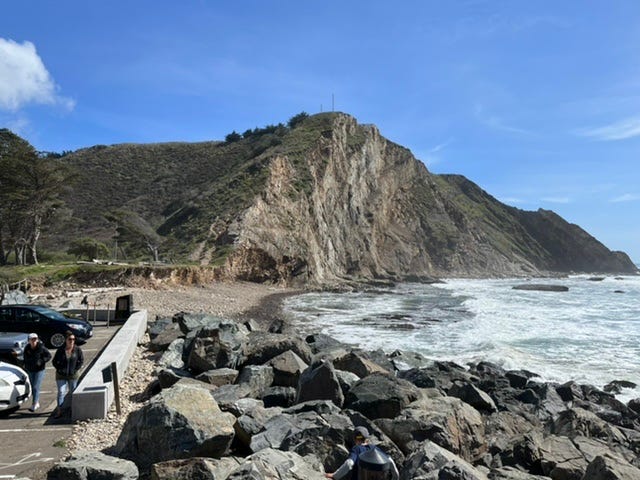Asking the Questions that Shape Our Future
Rediscovering a timely message from a historical scientist / Using systems-thinking to improve our culture/ Healing modes for eco-grief

Ideas as well as mountains can be magnificently large. This week I’m exploring some “10,000 foot” views around nature, culture, and climate from a few books I’ve been reading.
As we celebrate Father’s Day, I’m reminded of famous historical thinkers and authors, many of them fathers, who have been motivated to improve the world for all the children to come. Sending gratitude to all fathers everywhere who attempt this daily progress.
Robin Applegarth
You’re at Mother E, a free newsletter about our connections to nature and other species in a climate-changing world. If you missed the last article, it’s here: Keeping Company with Corvids
If this newsletter gets shortened by an email program or the images don’t show, you can read it on the website here.
WHAT DO CREATIVITY AND IMAGINATION have to do with science and climate? It turns out quite a bit. Some boundary-pushing thinkers have made imaginative leaps that led to new scientific and sociological discoveries. In offering us a new view of the world they changed our way of thinking and living.
I've been on a four-year quest to understand the ramifications of our climate crisis and what we can do to push back on the destructive forces. Several books I've read in the last month have overlapping themes about the importance of making connective and creative leaps, especially during adversity. Two of the books also talk about dealing with constant change and uncertainty, something we see more of as climate destabilization becomes more pervasive.
While the books span over two centuries of thinkers, the concept of seeing the "10,000-foot view" and applying creative thinking to human problems is more relevant now than ever before.
The Invention of Nature, Alexander Von Humboldt's New World, by Andrea Wulf
What can a naturalist born over 250 years ago teach us about climate change and holistic living? Alexander von Humboldt introduced the awareness that political, social, and economic forces are all major influences on the physical earth and climate.
Alexander von Humboldt (1769-1859) was the most famous scientist of his age, a visionary German naturalist and polymath whose discoveries forever changed the way we understand the natural world. Among his most revolutionary discoveries was a radical conception of nature as a complex and interconnected global force that does not exist for the use of humankind alone.
Andrea Wulf
Humboldt traveled widely and took hundreds of thousands of notes and observations over his 89-year life. He was the first scientist to see the connection between human-caused deforestation and the climate. He collected and documented thousands of species of plants and animals, studied weather and magnetic influences on Earth, and invented the weather isotherm lines used today. He was one of the first to understand volcanoes as being connected in a "ring of fire" and guess at plate tectonics, which was not officially discovered until the 20th century.
As he climbed the volcanic Mt. Chimborazo in Ecuador, Humboldt reached the 15,000 foot level and looked down its icy slopes and out to distant mountain ranges. He had a prodigious memory for details of all that he had studied. His mind was suddenly flooded with the thought that “everything was interwoven as with a thousand threads” and that life was a global force.
His mind reached back to all the plants, rock formations and measurements he had seen and taken on the slopes of the Alps, the Pyrenees… [and] everything that he had ever observed fell into place.
The Invention of Nature, by Andra Wulf
He stood out from other naturalists of the time because he was most interested in the connections between various parts of the natural world, crossing across disciplines. His boundless curiosity and creativity pushed the limits of human knowledge as he took in the macro view to see the patterns that linked everything.
Humboldt was generous with support for other scientists and widely shared his findings, helping to create a renaissance in knowledge of the natural sciences. His books inspired many famous people, from scientists like Charles Darwin to writers like Goethe and Thoreau, politicos and revolutionaries like Thomas Jefferson and Simon Bolivar, to poets like Wordsworth and Coleridge.
Reading about Humboldt's relationships and interactions with these historically famous people provides more insights into their characters and lives. He and then-U.S. President Jefferson spent over a week of late nights exchanging scientific notes, debating (Humboldt hated slavery), and talking about the geography of Mexico, which was unknown to Jefferson.
Humboldt was one of the preeminent thinkers of the nineteenth century, and his free university lectures attracted large crowds who would come an hour early to save seats. While eccentric, he still drew the patronage of monarchs as well as the love of the populace. His 1859 funeral precession in Berlin was over a mile long, with tens of thousands of mourners.
Alexander Humboldt's message was that nature was "a living whole" where organisms were bound together in a "net-like intricate fabric." We are still learning this message today as we seek to integrate human lives with the rest of the natural world in a sustainable way.
Designing Regenerative Cultures, by Daniel Christian Wahl
This unusual book, used as a textbook, is about using systems thinking and ecological design to understand the crises we're facing. The message is that we can redesign our culture, making it more adaptable, supportive and ecologically sustainable.
In other words, it's a blueprint for the 21st century on how to survive.
I saw a Twitter comment this week from an account called Wilderness Wanderer: "Apocalyptic feeling in the United States recently."
There is heavy-heartedness about the lack of progress on everything from gun control (children killed in their classrooms) to the climate crisis (damaging fires, heat, and floods this month—June 2022), democracy protection, and more. It's enough to make one want to pull the covers up and retreat when we feel that the darker forces are in control.
Instead, this thoughtful book asks us to "have conversations about what future we want for humanity” and to look for answers collaboratively, not just alone.
Questions, more than answers, are the pathway to collective wisdom.
Daniel Christian Wahl
This book is dynamic, training in a mode of thinking most of us are not used to. We want certainty and reassurances. Instead, the 21st century gives us complexity and a feeling of being unmoored at times. Wahl says, "Facing complexity means befriending uncertainty and ambiguity." He reminds us of the "transformative power of social innovation" and provides ideas on how to achieve that.
This is reading for those who want to find the inflection points—the places where pressure is best applied to achieve positive change— to shape our culture and institutions into something worth passing on to future generations.
While the goals may sound big, the ways to achieve them are local and scalable. Slow things down, pay attention to the micro as well as the macro view, observe connections you may not have noticed, and bring people together in a dialogue. Use systems thinking to get faster needed changes.
Think of culture-shaping as a science experiment that keeps adjusting to fit the needs of the time, people, and place. It can start with something as simple as getting a few people together to talk about what you want for your neighborhood or community and why it's important to you.
At the local and regional scale, feedback is faster and ecological limits are more immediately identifiable. Furthermore, by focusing on the local and regional scale, we can adapt solutions better to the specific conditions of a particular place.
Daniel Christian Wahl, Designing Regenerative Cultures
The ultimate question is, how does life (that includes us) create conditions conducive to more life? We desperately need to explore this foundational question as it relates to our survival.
Humans are still a young species, unsure of how we fit into Earth's collection of complex life forms. Are we a life-promoting keystone species or an extinction-causing destructive species? Maybe both are true, and our actions in the years coming up will determine our future and our legacy.
To pay attention, this is our endless and proper work.
Mary Oliver, poet
Generation Dread, Finding Purpose in an Age of Climate Crisis, by Britt Wray
The title of this book comes from the author's Substack blog. Young people are experiencing dread and depression over the climate crisis in greater numbers than any other generation.
This crucial book offers guidance on ways to develop the needed "emotional intelligence" and fortitude that can get us through the challenging times we face now and to come. Author Naomi Klein wrote a review of Generation Dread.
“A rare look at the internal work required to meaningfully confront the existential threats climate change poses to our institutions, our futures, and ourselves. If you are ready to feel through eco-anxiety, grieve what's lost, and imagine what comes next, read this courageous book."
Naomi Klein
Human mental health is closely tied to planetary health. "The stress of what's happening to the natural world is living inside people's bodies." We may grieve when we see a forest cut down, a group of people overcome by climate catastrophes, or a beloved species struggling to survive on Earth. Yet, this is the present we occupy, and truthful living compels us to acknowledge it. "When we kick the can of grief down the road, we become disconnected and avoidant."
The only way to survive grief is to care for what remains with even more heart than before.
Elizabeth Rush, writer
Britt Wray reaches across multiple cultures, from eastern Buddhist ideas to Native American wisdom to modern psychology, to bring coping and adjusting strategies to take care of people so people can take care of the planet. Her book calls us to grow the human spirit into something more resilient, compassionate, and connected with Earth.
Robin Applegarth
What if our species' most astonishing evolutionary innovation… and our saving grace—is that through us the transforming whole (universe) is able to know itself and become conscious of itself?
Daniel Christian Wahl, Designing Regenerative Cultures
What’s a question we should we be asking now? What do you want people to think about more often?
You can answer privately by responding to this email or publicly at the button below.
I’ll start— How do we bring local people into more vital conversations, both to solve urgent problems and build understanding?
Mother E is a free Substack newsletter published every other Sunday. To bring it to your email box, subscribe below.



As usual, a dive into the deeper questions we face as, so far, clumsy drivers at the steering wheel we have created for the living planet.
-Chris Poehlmann
One billion dollars and another 300 million+ donated to Stanford University for creating the School of Sustainability which will address these issues as one cohesive unit. Multi disciplines brought together, sharing research, data, actions, etc. Classes will begin this fall. Hopefully, other institutions will follow this structure.